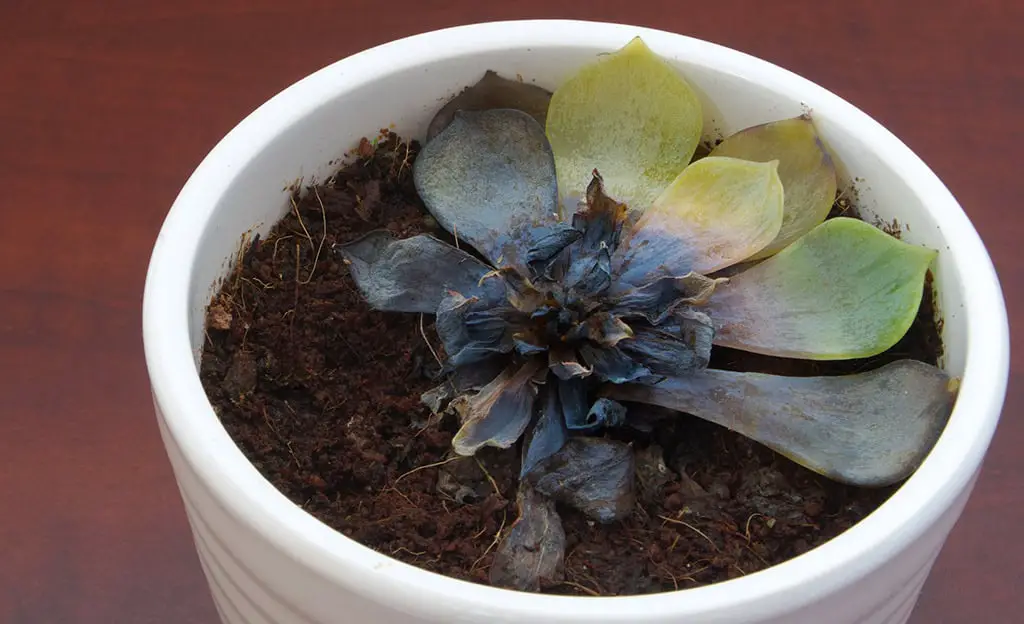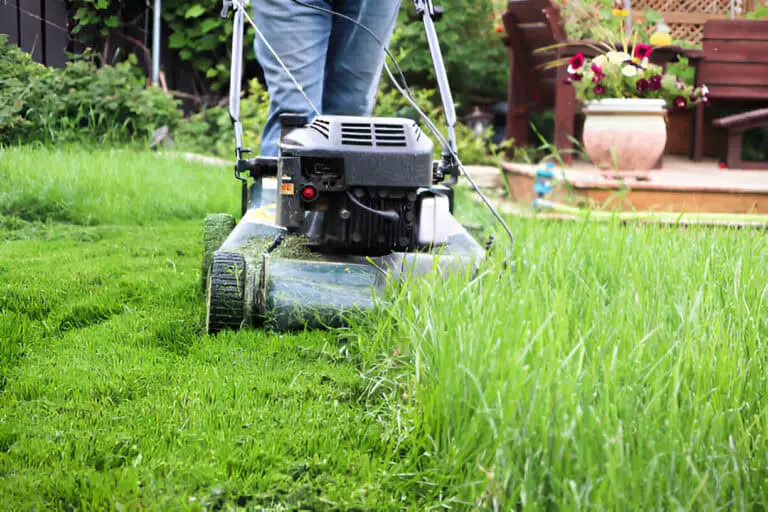Why Is My Cactus Turning Black? Cactus Diseases and Treatment

The cactus plant often comes in a range of beautiful colors, from classic green to wonderful shades of orange, pink, red, and yellow. However, if you notice that your cactus is turning black, then it’s usually a cause for concern.
So why is my cactus turning black? A blackened cactus will often be down to fungal diseases such as bacterial necrosis, crown rot, and phyllosticta pad spotting. In this article, I will aim to explain the common reasons a cactus houseplant is turning black, how it can be fixed, and what causes fungus on cactus.
It’s time to dive into the main section of our article and start answering that all-important question; ‘Why is my cactus turning black?’
What Causes Fungus on a Cactus?
First things first. Your cactus is more than likely turning black due to a fungal infection. It may look moldy or just be starting to blacken at the top. This, however, is not uncommon, and most plant species are relatively prone to mold or fungus lesions.
So, what causes fungus on a cactus? There is no particular cause of your cactus getting a fungus disease. Fungal organisms come in huge quantities with millions of different variants, most of which can survive by being dormant for long periods of time.
The important thing to note isn’t the type of fungus disease your indoor cactus has, but how to treat fungal diseases. This way you will be well equipped with knowledge if you start to notice your cactus turning black.
The most common types of cactus that are prone to fungal infections are Opuntia, Agave and Saguaro. However, pretty much all types of cactus are able to get these diseases, and it is not uncommon to wonder why your cactus is turning black.
| Related: Why Is My Cactus Turning White? |
Types of Cactus Diseases

Before we get into discussing fungus treatment for cactus, it is a good idea to better understand the types of cactus diseases. As mentioned above, if you are asking yourself, ‘Why is my cactus turning black?’, then it is, unfortunately, likely to be due to a disease.
There are so many different fungus organisms that can infect a cacti plant, so we can’t discuss all of them. The three most common types of diseases that cause a cactus to blacken are bacterial necrosis, crown rot, and phyllosticta pad spotting.
Bacterial Necrosis
What is bacterial necrosis? Bacterial necrosis is a type of fungal disease that is commonly found in the Saguaro cactus plant. It is a fairly simple infection that rots the tissue of the plant and can be both smelly and life-threatening for the saguaro cactus if left untreated.
The first sign of bacterial necrosis in a saguaro cactus is a blackened spot on the cactus that can smell and be soft. It will eventually progress to dark lesions that exude an odorous fluid and will create necrotic pockets, which will spread. Necrotic pockets are dead plant tissue and, if left untreated, will kill your cacti plant. Caught early enough, your saguaro cactus will have an 80% chance of survival.
You will also notice that the saguaro cactus necrosis develops a corky patch. This is the plant trying to heal itself, but any breach of the corked area will release the bacteria and further infect your plant. The corky looking patch will be blackened.
The only treatment for bacterial necrosis is to manually remove the infected area with a clean, sharp, sterilized knife. The bacteria can, however, live in the soil or ground, so may not fully save your cactus plant.
Crown Rot
What is crown rot? Crown rot is a soil-borne fungus and thrives in wet conditions and heavy soil. Luckily, cactuses enjoy fast-drying, airy soil, but this in no way means that your plant is safe from this fungal disease. Crown rot can affect almost any plant, shrub, tree, or vegetable patch, so if you’re a keen gardener, it is important to know the basics of this disease.
The first sign of crown rot on a cactus will be on the soil and will look similar to dry rot. Other signs may go unnoticed until the affected areas turn black, tan, or brown. By this point, it is usually too late to save your houseplant. This is why crown rot is so deadly—often you will not even know your plant has it until it is too late.
Once the fungus is in the soil, it is near impossible to eradicate.
How do you treat crown rot? Once crown rot gets to the advanced stages, where your cactus is blackened, it is very hard to reverse. The use of fungicides can help prevent the diseases, along with proper watering; however, once the disease has taken hold, it is hard to eradicate for good. As mentioned above, crown rot starts in the soil, so you should also think about repotting a cactus and replenishing the soil.
Phyllosticta Pad Spotting
What is phyllosticta pad spotting? Phyllosticta pad spotting, also known as prickly pear leaf spot, is a type of fungal disease found in prickly pear cactus and the rest of the Opuntia family. Tiny spores from the phyllosticta fungus colonize on the pads of a cactus and cause lesions.
If your cactus plant has phyllosticta pad spotting, then you should immediately remove it from any other plants you own, as the infection can easily spread. You should also carefully remove the infected pads on your prickly pear cactus to prevent any further spread of the disease.
Luckily, the damage of this fungal disease is mainly cosmetic and will not kill your cactus plant. Prickly pears are mostly affected by phyllosticta concava and are also more commonly known as dry rot.
One of the first symptoms of phyllosticta pad spotting you will notice will be black circular lesions that range from 1 to 2 inches in diameter. Reproductive structures called pycnidia produce these dark colors and will release the spores – as conditions change, the spots will fall out of the cactus and leave a scar.
As this is a weather-dominant disease, there will be no long term or serious damage to your cactus, provided the weather returns to being warm and dry.
| Also read: How to Make Cactus Grow Faster |
How Do You Treat Black Fungus on a Cactus?
So, you have answered the all-important question, ‘Why is my cactus turning black?’ and hopefully it will be one of the above three fungal diseases.
But how do you treat black fungus on a cactus? Typically, it depends on how severe the damage is. If you notice your cactus turning black in the early stages, then a simple cactus fungus treatment or fungicide spray can fix the issue.
If, however, the fungus lesions are covering a large area, then it will be best to start afresh with cuttings. To start a new plant with cuttings, you should use a sterilized knife to cut away at the healthy parts of the cactus.
If you are not quite ready to say goodbye to your wonderful cactus and the lesions aren’t covering the whole plant, then you can try and save the cactus by cutting away at the infected areas. This doesn’t work well with all fungi, such as crown rot, but may be effective for others.
You should remove more tissue than what appears to be infected so you can be sure you have removed all of the infected areas. Keep the plant dry and watch out for reinfection!
| Related: How to take care of small cactus |
Recommended Cactus Fungicides
If you have caught your cactus turning black in the early stages, then a simple fungicide treatment will work wonders! I have tried and tested a few fungal sprays and treatments over the years, and I have found the below three work best:
Bonide (BND148) – Infuse Systemic Disease Control, Fungicide Concentrate (16 oz.)
Bonide fungicide concentrate is probably, in my experience, the most effective treatment at stopping your cactus from turning black. This is most effective when you spot the issue in the early stages.
Use on an outdoor cactus, the instructions are easy to follow, and it’s simple to use. The fungicide is absorbed into the plant, ensuring it can’t be washed off by rain or sprinklers after the spray has dried.
Southern Ag – Liquid Copper Fungicide – Fungicide, 16oz
Liquid copper fungicide is always recommended when treating fungus on succulents and cactus. Copper fungicide is perfect for those wanting to avoid harsh chemicals. In a dissolved form, copper penetrates the plant tissue and will help control fungal diseases, including black spots!
BIOADVANCED 701287A 3-in-1 Insect, Disease, and Mite Control for Plants, 32-Ounce, Ready-to-Spray
This is perfect at combating multiple cactus problems! Not only will it stop black spots, it will also get rid of annoying pests! Use on outdoor cactus plants.
Why Is My Cactus Rotting?
As we have discussed above, the main reason your cactus is turning back (rotting), is likely to be because of fungus disease. But what causes fungus on cacti? Often, it will be due to overwatering – especially if the cactus is rotting from the bottom up. If you have an overwatered cactus, you’ll first get a soft, squishy cactus.
In general, cacti thrive in low moisture environments. The ideal temperature for a cactus is 70 to 75 f. in a bright, sunny area (south-facing window if you have an indoor plant) and requires next to no supplemental nutrients.
To help prevent cactus rot, you should only water when needed. Ensure that the soil is fully dry before you rewater. If you have a potted indoor cactus, be sure to be using a pot with drainage holes. If you don’t, then your cactus will end up sitting in water and the roots will get soggy—this will cause root rot and fungal diseases.
Black Spots on Cactus
OK, so you have read this article on ‘why is my cactus turning black?’ and are convinced it is not a fungal disease. We have spoken about lesions on a cactus and how they can look, but if you think your black spots on cactus are due to another issue, then you could be right!
Another reason you might notice black spots on a cactus could be down to temperature trauma. We all know that the cactus species enjoys a hot climate. These succulents are desert plants and can live on next to no water. Although these plants have adapted to different temperatures, both indoors and outdoors, cacti do not do well if there is a sudden temperature drop.
In very low temperatures, even just exposed for a few hours, there will be some visible changes to your beautiful plant—one of them being black spots on a cactus that looks wet at first.
Once dried, the black spots will turn dry and brittle and may even fall off—some serious case of frostbite! This will often be due to the cold weather causing tissue damage.
Luckily for you, freezing temperature damage is unlikely to cause serious problems, and your cactus plant will be able to replace the damaged tissue.
The black spots will disappear and return to normal. Just make sure you don’t get in the habit of leaving your cactus in freezing conditions! If you have an outdoor cactus and live in a cold environment, you should think about moving the plant indoors for the winter months.
How to Treat Cactus With Black Spots
OK, so I know that I have said a cactus that is damaged from temperature trauma will fix itself; if the condition is advanced, then some cutting may need to be involved.
I’m talking about whether the black spots on cacti cover large areas of the plant. Though this means that it may take a little time and patience, your cacti aren’t completely doomed and can be restored to a healthy, happy condition.
If the black spots are covering a whole arm/pad, then you should use a sterilized knife to completely cut it away.
Why Is My Cactus Turning Black? A Quick Recap!
I hope you have enjoyed this article on the ever-important question, ‘Why is my cactus turning black?’. Hopefully, you are now well equipped and knowledgeable in why your cactus is turning black and have found the solution you were looking for.
To recap, we have discussed a number of topics. Primarily, your cactus will be turning black due to a fungus infection. This will commonly be bacterial necrosis, crown rot, or phyllosticta pad spotting.
We have discussed each fungal disease in detail, along with types of cactus diseases and also what causes fungus on a cactus. We have also given you a number of handy tips on how you treat black fungus on a cactus.
We also discussed black spots on cacti due to temperature trauma. Cactus enjoys being in warm climates, so if you live in a cold area, then you should consider only having indoor cactus plants where you can control the temperature!






